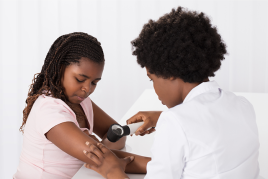Thinning hair and hair loss: Could it be female pattern hair loss?

For most women, FPHL begins in midlife, when a woman is in her 40s, 50s, or 60s. It can begin earlier for some women.
FPHL is a progressive condition. This means women tend to continue losing hair. But women do not lose all of their hair, as do some men. Instead, your part often gets wider. Hair near your temples may recede. Without treatment, some women eventually develop widespread thinning.
Treatment can prevent hair loss from worsening and help women regrow their hair. Treatment delivers the best results when started at the first sign of hair loss.
How can I tell if I have female pattern hair loss?
It’s best to make an appointment to see a dermatologist. Dermatologists are the experts in diagnosing and treating hair loss. A dermatologist can tell you whether it’s FPHR or something else that is causing your hair loss. Other causes of hair loss can look like FPHL, so it’s important to rule out these causes.
What causes female pattern hair loss?
It’s hereditary. You inherit the genes from your mother, father, or both. Because FPHL is more common after menopause, hormones may also play a role.
How do dermatologists treat female pattern hair loss?
To give women optimal results, dermatologists may use more than one hair-loss treatment. For FPHL, treatment options include the following.
Minoxidil (meh-nox-eh-dil): Long used to treat male pattern hair loss, the US Food and Drug Administration (FDA) has approved this non-prescription treatment for women. Today, it is the most-recommended treatment for FPHL. Products containing either 2% or 5% minoxidil have been approved to treat FPHL.
What should I know about using minoxidil? For the first two to eight weeks, you may notice a temporary increase in hair loss. This stops when your hair begins to regrow.
A common side effect of minoxidil is an irritated scalp, which may cause dryness, scaling, itching, and/or redness on your scalp. If this happens, it’s best to stop using minoxidil and see your dermatologist.
Another possible side effect is to see hair growing in places other than your scalp, such as on your cheeks and forehead. If this happens, you can limit it by:
Trying to apply minoxidil only to your scalp and avoiding other areas
Washing your face after you apply minoxidil to your scalp
When will I see results? Hair grows slowly, so it takes time to see results. You’ll need to use minoxidil continuously for about six to 12 months before you know how well it will work for you.
If this medication works for you, you’ll need to use it every day to continue getting results.
If you stop applying minoxidil, you lose its benefits. Because minoxidil helps you maintain your hair's thickness, some hairs may look and feel thinner. You'll also gradually notice that you're shedding more hair.
Minoxidil, pregnancy, and breastfeeding: Women who are pregnant or plan to become pregnant should avoid minoxidil. Studies of pregnant animals have shown minoxidil can be harmful to a developing fetus.
Women who are breastfeeding should also avoid minoxidil. Traces of minoxidil may pass into breast milk, which can be harmful to a nursing infant.
How is minoxidil used? You apply it to your dry scalp. Some products you should apply once a day. Others you apply twice a day.
Minoxidil, pregnancy, and breastfeeding
Women who are pregnant, plan to become pregnant, or who are breastfeeding should avoid minoxidil.
Prescription medications: Some prescription medications have proven effective in helping women with FPHL grow hair and prevent FPHL from worsening.
To date, these medications have received FDA approval to treat other conditions, but not FPHL. Doctors often prescribe FDA-approved medications to treat medical conditions other than those for which the drug was approved.
A dermatologist may prescribe one of the following medications to treat FPHL. Each of these medications is a pill.
Spironolactone (speh-ren-no-LAK-tone): This medication is a diuretic, which has been prescribed for decades to treat hair loss. It is a common treatment for FPHL because it can help restore hair growth and prevent hair loss from worsening.
Before taking spironolactone, be sure to tell your dermatologist about your medical conditions, including kidney and adrenal gland problems. Also, be sure that your dermatologist knows all the medications and supplements you take.
Your dermatologist may prescribe another medication to treat FPHL, such as finasteride (fi-NAS-ter-ide), flutamide(flu-TA-mide), or dutasteride (doo-TAS-ter-ide).
With any medication, side effects are possible. Ask your dermatologist about possible side effects that you might experience while taking one of these medications.
When will I see results? If your dermatologist prescribes one of these medications, you’ll need to take it for 6 to 12 months before you’ll know if it works for you. No hair growth within 12 months means the medication won’t work for you.
Like minoxidil, once you stop taking a prescription medication, you lose the hair that grew. This happens in about three to four months.

Dermatologists recommend that all pre-menopausal women use birth control while taking one of these prescription medications.
Hair transplant: Long used to treat hair loss in men, a hair transplant may be an option for some women with FPHL.
The hair transplant has come a long way since the days of hair plugs. Today, most hair transplants look completely natural.
Not everyone is a good candidate for a hair transplant though. If the hair on your scalp is sparse all over, you may not have enough healthy hair to transplant. A hair transplant surgeon, many of whom are dermatologists, can tell you if a hair transplant may help restore your hair.
Are there other treatment options for FPHL?
Women want innovative treatments for FPHL. To meet this need, researchers continue to look for new ways to stimulate hair growth and stop hair breakage. Other treatments that you may find for FPHL include the following.
Lasers for at-home use: The FDA has approved laser combs, helmets, and other devices, which are available without a prescription, to treat hair loss at home. These devices emit a low level of laser light that may help stimulate new hair growth. A few studies show that this can be effective for treating FPHL.
As with minoxidil and prescription medicines, you must continue using an at-home laser device to see results. We still do not know whether these devices are safe for long-term use or if they can continue to produce new hair growth.

It is believed the platelets help stimulate your cells to grow hair.
Researchers are just beginning to study this therapy as a treatment for hair loss. The early findings show promise, but more studies are needed to know whether this is a safe and effective treatment for FPHL.
Stem cells: Using stem cells to treat FPHL is still in the experimental stages. Like platelet-rich plasma therapy, more studies are needed to know whether stem cells are a safe and effective treatment for FPHL.
Supplements: Many supplements, including biotin and folic acid, are said to help grow and thicken hair. In studying these different supplements, the findings have been mixed. In most studies, the supplements had no effect on hair growth and thickness.
In one study, however, 120 healthy women had thicker hair and less hair loss after taking specific omega-3 fatty acids, omega-6 fatty acids, and antioxidants. They took this combination for six months. If these results can be repeated in other studies, we’ll have some evidence to recommend taking these supplements.
In the meantime, you’re sure to find supplements that promise to regrow hair. Before taking any of these, it’s best to check with your dermatologist. Some supplements can interact with medications. Your dermatologist can also tell you whether we have any evidence to show that the supplement helps regrow hair.
Hair loss shampoos: These shampoos tend to do one of the following.
Help your hair hold moisture, which makes hair look fuller and thicker
Lessen breakage, which can reduce thinning
While hair loss shampoos may do the above, they cannot regrow hair or prevent hair loss from worsening.
A dermatologist’s diagnosis is best before treating hair loss
If you think you have FPHL, it’s important to see a dermatologist for a diagnosis. Women develop hair loss for many reasons. Other common causes of hair loss in women can look a lot like FPHL. Each of these causes requires different treatment. Without the right treatment, hair loss often continues.
You can find a dermatologist in your area by going to Find a Dermatologist.
Key points
See a dermatologist to make sure that you have FPHL, and to rule out another condition, which may be causing your hair loss
Treatment works best when started at the first sign of hair loss
Minoxidil is the most-recommended treatment for FPHL
Whether the newer treatments for hair loss, such as the lasers for at-home use, are safe for long-term use and can continue to stimulate new hair growth remain to be seen.
Images
Image 1: Used with permission of Journal of the American Academy of Dermatology. J Am Acad Dermatol 2004;51(2):191.
All other images from Getty Images.
References
Atanaskova Mesinkovska N, Bergfeld WF. “Hair: what is new in diagnosis and management? Female pattern hair loss update: diagnosis and treatment.” Dermatol Clin. 2013 Jan;31(1):119-27.
Dinh QQ, Sinclair R. “Female pattern hair loss: Current treatment concepts.” Clin Interv Aging. 2007 Jun; 2(2): 189–99.
Gkini MA, Kouskoukis AE, et al. “Study of platelet-rich plasma injections in the treatment of androgenetic alopecia through an one-year period.” J Cutan Aesthet Surg 2014;7:213-9.
Gupta, AK, Foley KA. “5% minoxidil: Treatment for female pattern hair loss.” Skin Therapy Lett. 2014 Nov-Dec;19(6):5-7.
Jimenez JJ, Wikramanayake TC, et al. “Efficacy and safety of a low-level laser device in the treatment of male and female pattern hair loss: A Multicenter, Randomized, Sham Device-controlled, Double-blind Study.” Am J Clin Dermatol. 2014; 15(2): 115–27.
Le Floc’h C, Cheniti A, et al. "Effect of a nutritional supplement on hair loss in women.” J Cosmet Dermatol. 2015 Mar;14(1):76-82.
Lee SH, Zheng Z, “Therapeutic efficacy of autologous platelet-rich plasma and polydeoxyribonucleotide on female pattern hair loss.” Wound Repair Regen. 2015 Jan;23(1):30-6.
Lucky AW, Piacquadio DJ, et al. “A randomized, placebo-controlled trial of 5% and 2% topical minoxidil solutions in the treatment of female pattern hair loss.” J Am Acad Dermatol. 2004 Apr;50(4):541-53.
Rogers NE, Avram MR. “Medical treatments for male and female pattern hair loss.” J Am Acad Dermatol. 2008 Oct;59:547-66.
Schiavone G, Raskovic D. et al. “Platelet-rich plasma for androgenetic alopecia: A pilot study.” Dermatol Surg. 2014 Sep;40(9):1010-9.
Shin H, Ryu HH, et al. “Clinical use of conditioned media of adipose tissue-derived stem cells in female pattern hair loss: A retrospective case series study.” Int J Dermatol. 2015 Jun;54(6):730-5.
Unger WP, Unger RH. “Hair transplanting: An important but often forgotten treatment for female pattern hair loss.” J Am Acad Dermatol. 2003 Nov;49(5):853-60.
van Zuuren EJ, Fedorowicz Z, et al. “Interventions for female pattern hair loss.” Cochrane Database Syst Rev. 2012 May 16;5:CD007628.
Last updated: 12/13/22
 Molluscum contagiosum: How to safely treat it
Molluscum contagiosum: How to safely treat it
 Biosimilars: 14 FAQs
Biosimilars: 14 FAQs
 Practice Safe Sun
Practice Safe Sun
 Relieve uncontrollably itchy skin
Relieve uncontrollably itchy skin
 Fade dark spots
Fade dark spots
 Untreatable razor bumps or acne?
Untreatable razor bumps or acne?
 Laser hair removal
Laser hair removal
 Scar treatment
Scar treatment
 Botox
Botox
 Free materials to help raise skin cancer awareness
Free materials to help raise skin cancer awareness
 Dermatologist-approved lesson plans, activities you can use
Dermatologist-approved lesson plans, activities you can use
 Find a Dermatologist
Find a Dermatologist
 What is a dermatologist?
What is a dermatologist?